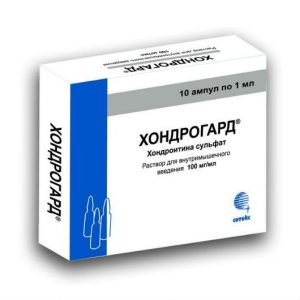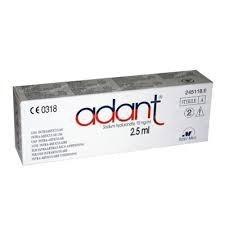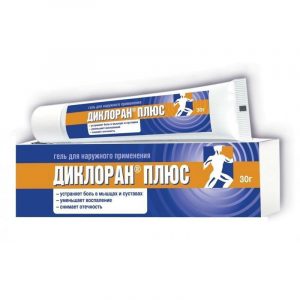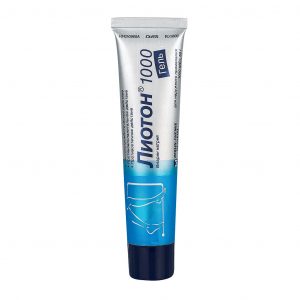Description
Release form
The solution for i / m administration is clear, colorless to slightly yellow in color, with a faint characteristic odor of benzyl alcohol.
Pharmacological action
Diclofenac, a derivative of phenylacetic acid, has anti-inflammatory and analgesic effects. The mechanism of action is due to the indiscriminate inhibition of the activity of cyclooxygenase 1 and 2, which leads to a suppression of the synthesis of prostaglandins in the focus of inflammation.
When applied topically in the form of eye drops, diclofenac reduces eye inflammation resulting from infection, trauma or surgery, reduces myosis in surgical operations, and reduces prostaglandin synthesis in the anterior chamber.
Pharmacokinetics:
The maximum concentration of a substance in the cornea and conjunctiva is reached by 30 minutes after instillation. The drug is rapidly excreted from the body, complete elimination is observed after 6 hours.
The drug penetrates the anterior chamber of the eye into the systemic circulation in therapeutically significant concentrations.
Indications
– Inhibition of myosis during cataract surgery (the drug does not have mydriatic properties and does not replace standard drugs that cause pupil dilation)
– treatment and prevention of inflammatory processes after surgery on the eyeball
– prevention of cystic edema of the poppy
cataract surgery – treatment of non-infectious conjunctivitis
– treatment and prevention of post-traumatic inflammatory process in case of penetrating and non-infectious drooping wounds of the eyeball (as an addition to local antibiotic therapy).
Contraindications
Hypersensitivity to the drug, impaired hematopoiesis of unknown origin, erosive and ulcerative processes in the gastrointestinal tract in the acute stage.
Like other non-steroidal anti-inflammatory drugs (NSAIDs), the drug is contraindicated in patients with asthma attacks, urticaria, acute rhinitis, associated with the use of acetylsalicylic acid or other drugs that inhibit the activity of prostaglandin synthetase. There is the possibility of cross-sensitivity to acetylsalicylic acid, phenylacetic acid derivatives and other NSAIDs.
Intraocular use of the drug during surgical procedures is contraindicated.
Precautions:
Epithelial herpetic keratitis (including a history of) diseases that cause bleeding disorders (including hemophilia, prolonged bleeding time, tendency to bleed), bronchial asthma caused by taking acetylsalicylic acid in old age.
Use during pregnancy and lactation
Use during pregnancy and lactation is possible in cases where the expected benefits to the mother outweigh the potential risk to the fetus or newborn.
Special instructions
The anti-inflammatory effect of NSAIDs, including diclofenac, may complicate the diagnosis of ocular infections. Patients with an infection of the eye or with a potential risk of its development, the drug should be prescribed along with appropriate antibiotic therapy.
Wearing soft contact lenses is not recommended during treatment with the drug. When using hard lenses, they should be removed before using the drug and put on again 15-20 minutes after instillation.
Pressing the lower lacrimal opening or closing the eyes within 3 minutes after instillation into the conjunctival sac reduces the drug into the systemic circulation, which contributes to a more effective local action of the drug and a decrease in the incidence of systemic side effects.
Do not touch the tip of the pipette to the eye.
Impact on the ability to drive transp. Wed and fur .:
During treatment, care must be taken when driving vehicles and engaging in other potentially dangerous activities that require increased concentration of attention and speed of psychomotor reactions.
Composition
1 ml diclofenac sodium 25 mg
Excipients:
benzyl alcohol – 35 mg,
sodium disulfite – 0.8 mg,
mannitol – 10 mg,
sodium hydroxide – 0.4 mg,
propylene glycol – 200 mg,
d / u water – up to 1 ml.
Dosage and Administration
Topically.
To inhibit intraoperative myosis, the drug is instilled into the conjunctival sac for 2 hours at intervals of 30 minutes (4 times) before surgery.
For the prevention of cystic edema of the macula, the drug is instilled 1 drop 3 times a day for 2-3 weeks after surgery.
For the treatment of post-traumatic inflammatory process in case of non-penetrating eyeball injuries, 1 drop is instilled in 4-6 hours.
The duration of treatment is determined by the doctor, depending on the course of the disease and the needs of the patient.
For example, to reduce the severity of pain after eye surgery (after refractive surgery), the drug should be instilled 1-2 drops per hour before surgery, 1-2 drops in the first 15 minutes after surgery and 1 drop every 4-6 hours within 3 days after surgery.
Other indications: 1 drop 3-4 times a day, depending on the severity of the condition. The course of treatment can last from 1 to 2 weeks.
Operating procedure with a dropper tube (see fig.):
1. Separate one dropper tube, put the rest back into the packaging.
2. Open the dropper tube (after making sure that the solution is in the lower part of the dropper tube, turn and rotate the valve with rotary movements).
3. Instill the required amount of the drug into the eyes.
4. Close the dropper tube with a valve.
An opened dropper tube can be stored for no more than 24 hours, then the dropper tube should be discarded.
Side effects
The adverse events listed below are listed according to frequency of occurrence. The frequency of occurrence is determined as follows: very often (? 1/10), often (? 1/100 and <1/10), infrequently (? 1/1000 and <1/100), rarely (? 1/10000 and <1 / 1000), very rarely (<1/10000, including isolated cases). Often: temporary mild or moderate eye irritation. Infrequently: itching in the eyes, conjunctival hyperemia and blurred visual perception (immediately after instillation). Rarely: spot keratitis or corneal lesions (after repeated use of the drug). In patients at risk of developing corneal lesions, for example, when using glucocorticosteroids or as a result of various diseases (infections, rheumatoid arthritis), with repeated use of the drug in rare cases, it may develop vision-threatening complications: ulcerative or acupressure keratitis, corneal epithelial defects, edema and thinning cornea. Very rare: shortness of breath and worsening of asthma, eye pain. Allergic reactions Rarely: conjunctival hyperemia, allergic conjunctivitis, redness, itching and swelling of the eyelids, urticaria, rash, eczema, erythema, pruritus, hypersensitivity, cough and rhinitis. Drug Interactions Instillation of NSAIDs, including diclofenac in the conjunctival cavity, together with glucocorticosteroids (GCS) in patients with severe corneal inflammation can lead to progression of corneal lesions. Caution should be exercised when using the drug with corticosteroids in patients with severe corneal inflammation. If necessary, it can be used simultaneously with other eye drops, including those containing corticosteroids. In this case, the interval between instillations should be at least 5 minutes to prevent the active substances from being washed out in subsequent doses. Overdose There is no evidence of an overdose of the drug. The drug is safe if taken orally, since 5 ml of the solution contains 5 mg of diclofenac (3% of the maximum oral daily dose of diclofenac for adults). Storage Conditions At a temperature not exceeding 25 ° C. Keep out of the reach and sight of children. Expiration 2 years. After opening the vial – 1 month. Do not use after the expiry date. active substance Diclofenac Pharmacy terms Prescription Dosage form solution for injection Grotex Ltd. LLC, Russia




